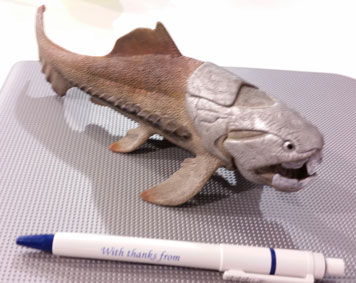What Other Types of Fish Lived Alongside Placoderms?
At Everything Dinosaur, we receive lots of emails from fans of prehistoric animals. Many of these emails contain questions. For example, we received an enquiry earlier this week asking what other types of prehistoric fish lived alongside placoderms? That is an excellent question! We are no experts on the evolutionary development of fishes, but since the questioner wanted to know about brackish and freshwater environments in the Devonian, we thought we would try to help.
Defining Placoderms
The Devonian covers approximately sixty million years. It is often referred to as the “Age of Fishes”, due to the radiation of several fish types including the Sarcopterygii (lobe-finned fishes), the placoderms and sharks (cartilaginous fish otherwise referred to as chondrichthyians).
(Class Placodermi) represents an extremely diverse and varied group of jawed fishes that evolved during the Silurian, thrived in the Devonian but seem to have died out during the end-Devonian mass extinction. They were the first fish to evolve a pair of pelvic fins. Several Orders have been described all united by the defining characteristic of the Placodermi, their heads and thorax being covered by a series of articulated, armoured plates.
Perhaps the best-known placoderm is Dunkleosteus (D. terrelli). It was a member of the Arthodira and is thought to represent the earliest vertebrate “superpredator”.
Picture credit: Everything Dinosaur
The picture (above) shows the Schleich Dunkleosteus figure.
To view the Schleich range of prehistoric animal models: Schleich Prehistoric Animal Models.
Non-marine Vertebrate Fauna of the Emsian Faunal Stage
The query requested information regarding non-marine fish from the Early Devonian. We decided to examine the fossil record of freshwater and estuarine fish from the Emsian faunal stage of the Early Devonian. This would cover the period of Earth’s history from 407.5 million years ago to around 393 million years ago.
Although it is thought that vertebrates evolved in marine environments, by the Early Devonian many different types of fish had adapted to brackish or freshwater. Placoderms are known from non-marine palaeoenvironments of the Early Devonian. In addition, heterostracans are also associated with non-marine palaeoenvironments.
Heterostracans (Heterostraci) are an extinct subclass of the Agnatha (jawless fishes). There is some fossil evidence to indicate that jawless fish of the Pteraspidiformes Order, most notably pteraspids and drepanaspids lived in brackish and freshwater environments. These types of fish may have been preyed upon by the jawed placoderms. A scientific paper exploring potential predator/prey relationships was published in 2019 (Randle and Sansom).

Picture credit: Julio Lacerda/The University of Manchester
During the Silurian and Early Devonian, possible predators of pteraspids and drepanaspids could have been jawed vertebrates as well as eurypterids.
To read Everything Dinosaur’s blog post about this research: Battle of the Early Vertebrates.
Answering Queries from Customers
We replied to the customer and emailed them some information in response to their query. We also included links to two blog posts that examined the Placodermi and potential Early Devonian food webs in more detail.
The customer emailed later to thank us for the information.
Visit the Everything Dinosaur website: Visit Everything Dinosaur.


